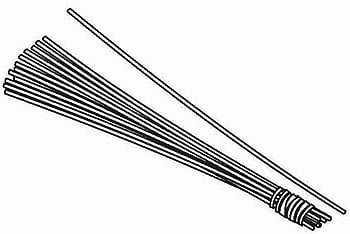The easy availability of broomsticks inspires us to make lots of exciting things, such as spinners and bows and arrows, with them

The coconut broom can be found in the poorest house – be it in a city or a village. There are numerous modern house-cleaning gadgets like vacuum cleaners etc, but even the most tech-savvy household can’t do without the humble broom! The sticks in the broom are the ribs of the coconut palm fronds. They still remain the most environmental-friendly aid for cleaning.
Individual broomsticks may appear thin, but they are fairly strong and pliable. Often it’s the thin ends of the broomsticks which are used for cleaning. And as they wear out, their length decreases and finally the broom is thrown away. Thus discarded brooms have the thickest and strongest sticks!
The pliability of broomsticks makes them ideal for making bows and arrows. As you pull the bow, it slowly stores your muscular energy and then — in one go — it releases all the energy. This enables the arrow to travel far.
Sudarshan Chakra
For hundreds of years children have made a spinner using two broomsticks – one short (6-cm) and one long (18-cm) and tying them at a slant. They weigh down the long stick by tying a stone. Instead of the stone it is easier and safer to insert a rubber eraser.
Then perch the joint on your index finger as shown and spin it anti-clockwise. It will not fly away and will keep spinning merrily. The stone can sometimes come loose and hit someone. So, the eraser is much safer.
Broomstick Tables
Tables are often learnt by rote. This repetitious drill might help quick recall, but it kills the whole joy of learning. With only 18 equal length broomsticks you can discover the whole world of tables.
Lay three brooms horizontally, two vertically. Count their junctions or nodes. There will be 6. Similarly, 3 vertical and 4 horizontal sticks will have 12 junctions. A grid of 9 lying and 9 standing sticks will have 81 junctions so 9 x 9 = 81. By crisscrossing broomsticks on each other and counting their junctions you can make your own multiplication chart. After all, multiplication is repeated addition.
It is very difficult to understand that 0 x 0 = 0.
In this picture there is no vertical stick. As there is no junction, so 2 x 0 = 0. Now remove one stick so that only one remains. This will be 1 x 0 = 0. Now remove this lone stick too so that nothing remains. This can be written as 0 x 0 = 0. This is how the very abstract concept of 0 x 0 = 0 can be concretised.
A card strip can be considered equal to 10, a broomstick as 1. The picture (below) is a graphic representation of 12 x 13. Strip-on-strip means (10 x 10 = 100).
Strip-on-stick equals (10 x 1 = 10). And stick-on-stick is just one (1 x 1 =1).
Add 100+10+10+10+10+10+10+1+1+1+1+1+1 and you will get 156.
This is a very beautiful dissection of a multiplication.
Simple Stand
Take six strong broomsticks, each 50-cm long. Tie them as shown with rubber bands to make a very elegant Tetrahedron. A tetrahedron (tetra = four; hedrons = triangles) is made of four triangles. It is the strongest structure found in nature. The structure of methane gas is a tetrahedron with four atoms of the hydrogen at the four corners and the carbon in the centre.
Sewing Machine
Take a 6-cm x 4-cm piece of old rubber slipper. Carefully make three holes with a compass point. Take a 70-cm long, strong and pliable broomstick. Bend and insert its ends in the end holes to make an elliptical loop. Push another strong cross-stick in the middle hole.
Now take two 25-cm long sticks and weave them above the middle stick and below the loop sticks. Then hold both these sticks and spin the toy. You will be surprised that it makes a sound akin to a foot-operated sewing machine.
Now place a fresh soft leaf on the cross stick. Again weave the twin-sticks as earlier and spin the mechanism. Apart from the sound of a sewing machine the leaf will have a series of holes – almost like the holes made by a sewing machine!
